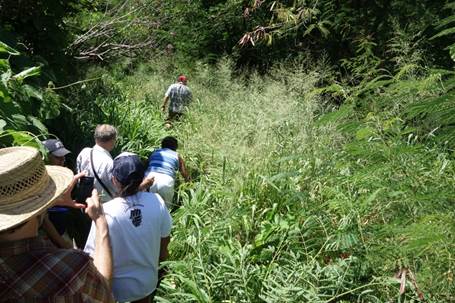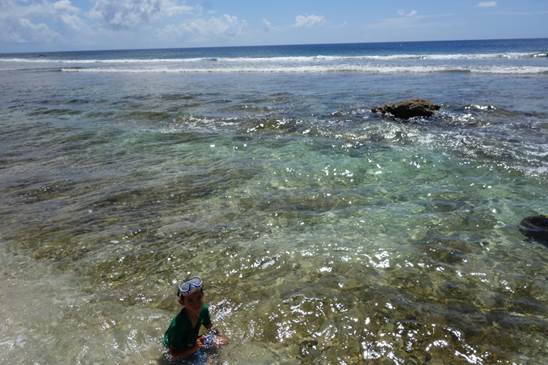The Tinian Monarch is a flycatcher found only on the 39 square mile island of Tinian, which is adjacent to the island of Saipan and part of the Commonwealth of the Northern Marianas Islands (CNMI). The species was listed as endangered by the U.S. Fish and Wildlife Service in 1970 because of persistent low populations after the heavy bombing of Tinian during WWII when their numbers fell to about 50 individuals. Following additional field studies the species’ status was lowered to threatened in 1987 and in 1995 it was removed from the Endangered Species List.
Because of fluctuating populations – primarily from typhoons – the Center for Biological Diversity has petitioned the USFWS to re-list the species as threatened. The Chamorro (primary language of the CNMI) name is Chickurikan Tinian and is known as Liteightipar in Carolinian. This bird is small – about 6 inches in length. The under parts are a light rufous with olive brown upper parts, brown wings and tail, and two distinctive white wing bars with a white rump and undertail. They are found in native limestone forests, secondary forests, and tangantangan forests.
Densities are highest in limestone forests. These birds eat insects, though there was one report of them preying on a lizard. They will forage by moving through the mid-level canopy gleaning invertebrates from branches, bark, and leaves and may chase after flying insects. Prey brought to mates sitting on eggs includes moths, butterflies, ants, caterpillars, and a variety of insects. Monarchs can at times show aggression and have been known to fly off their nest directly to intercept an intruder – including Collard Kingfishers, which are about 4 times their size.
Flocks of 3-6 have been observed moving through the forest together, likely family groups. While they also have been observed chasing Rufous Fantails, which are more their size, they also can be tolerant of other species and have been observed foraging close to Bridled White-Eyes. The Tinian Monarch breeds year-round but some studies show some peaks in September, January, and May – which may be related to rainfall. Nesting success is highest in native limestone forests. Nests are made from dried Casuarina equisetifolia needles, dried leaves, grasses, vine tendrils, spider webs, and feathers. Nests are always placed at the junction of a vertical branch. 1-3 eggs are laid and both the male and female will incubate the eggs, which hatch in about 15 days.
In June I was on Tinian for work and thought I spotted a pair flitting around the bush but despite my best pishing( http://birding.about.com/od/birdingbasics/a/Pishing.htm ) I couldn’t convince them to show themselves and, being an honest birder, couldn’t count the sighting. But later that day we were driving the rental van through some brushy roads when a pair flew into the road corridor and landed on a branch in clear view.
Debra, our local Chamorro guide for the day, mentioned that she occasionally gets hired by worldwide birders who want to see this species. This included an older gentleman who wanted to photograph the bird on its nest sleeping, when they fold their wings over their head. Unbeknownst to her, the gentleman was a bit frail so Debra was the one who was dragging a ladder around the forest for him. Despite the travails it was a successful expedition.

———————And now for the pitch. I been working with colleagues here at ESA and an environmental law group out of San Francisco to advise the CNMI on how to respond to a Navy proposal and EIS for using Tinian and Pagan, an island 120 miles north, for bombing practice and military maneuvers ranging from ground troops, to amphibious vehicles, tanks, and a host of live fire training. While there is a lease agreement on Tinian for Navy practices it does not include live fire training and no training occurs on Pagan.
The Navy has threatened to use eminent domain if they don’t get an agreement. The Navy already had decimated one island in the CNMI – Farallon de Medinilla – which they purchased for $20,000 after WWII, for bombing practice. If the current proposal goes through the Navy will control 24% of the land of the CNMI. The CNMI total land mass is equal to 17% of Rhode Island – a series of very small specks in the ocean.
Needless to say, the removal of Tinian Monarch habitat and the disturbance from live fire exercises has caused deep concern for this and other endemic and rare species (including my favorite – the endangered Micronesian Fruit Bat).

Also see:
